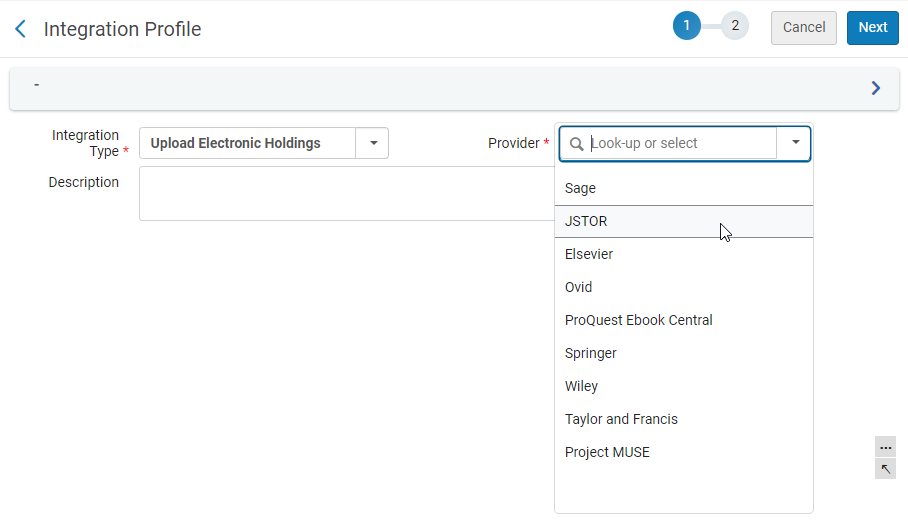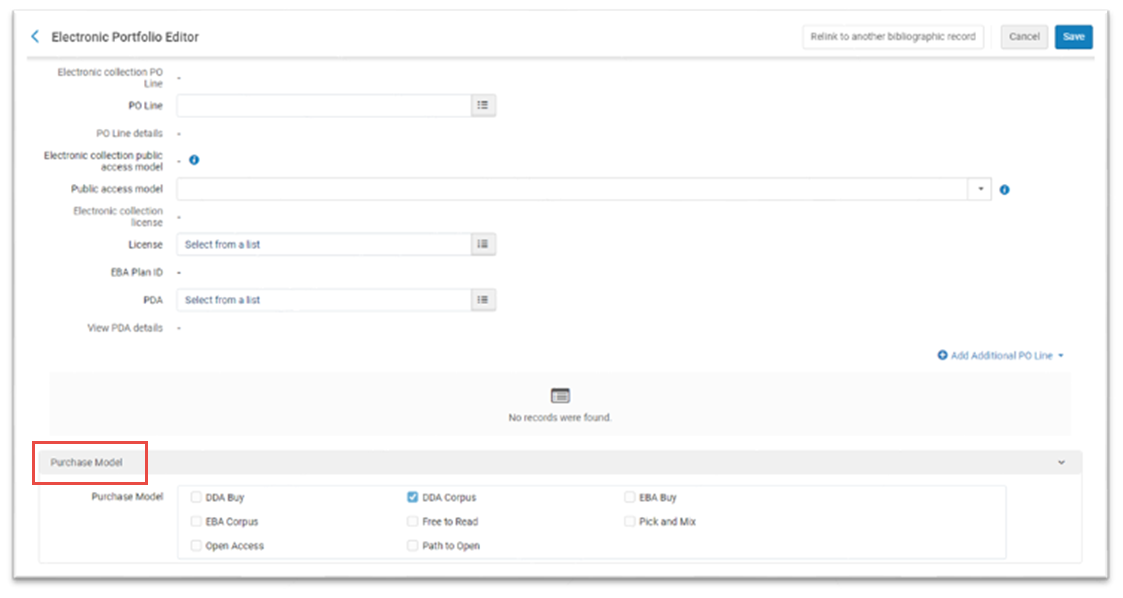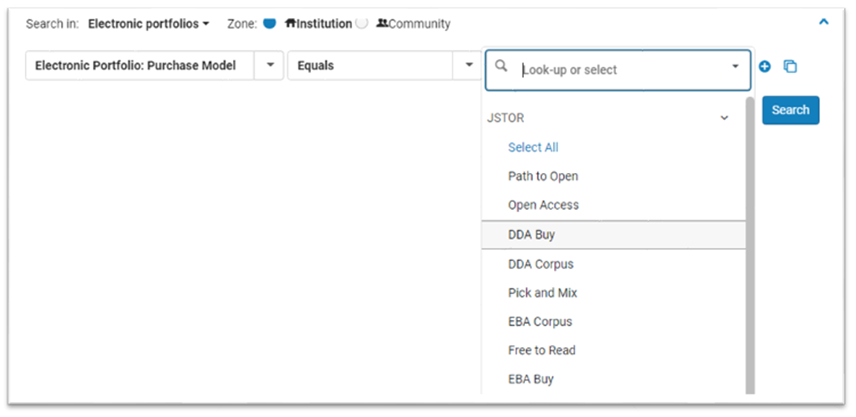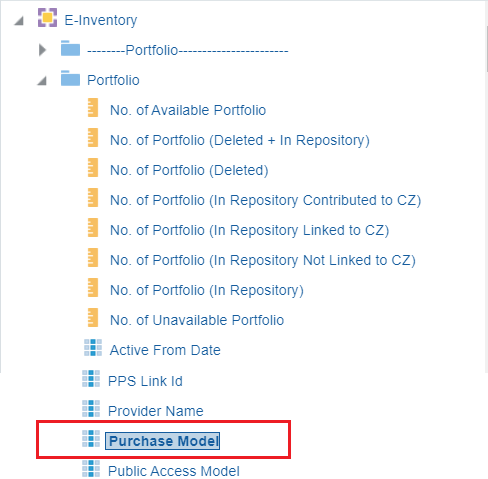Upload Electronic Book Holdings from JSTOR
Creating the JSTOR Integration Profile
- Obtain an institution token from JSTOR.
To obtain your JSTOR token ID, please log in to JSTOR’s Admin site and go to the Alma linking tab.
- Confirm that the JSTOR electronic collections for which you are updating holdings (JSTOR AUTOHOLDINGS BOOKS Collection; ID = 615400000000000569) are active collections in Alma. See Activating the JSTOR Electronic Collections from the Alma Community Zone for more information.
On the Integration Profile List page (Configuration Menu > General > External Systems > Integration Profiles) select Add Integration Profile to open the External System wizard for configuring an integration profile.
- For the Integration Type parameter, select Upload Electronic Holdings.
- For the Provider parameter, select JSTOR.
 Configuring Upload Electronic Holdings Integration Profile, step 1
Configuring Upload Electronic Holdings Integration Profile, step 1 - Add a description (optional) and select Next.
- Complete the Upload Electronic Holdings configuration section using the information in the table below.
Upload Electronic Holdings Section Parameter Description Select Active to make this an active profile. The default setting is Inactive.
Institution
token idEnter the institution token ID that you received from JSTOR.
File format
Select the KBART file format.
Group
The Group parameter is displayed only when you have the multi_campus_inventory_management customer parameter set to true.
Use this parameter to select one or more groups from the list of multi-campus options in the drop-down list. This parameter is optional, so you may also choose to leave it blank.
With the multi_campus_inventory_management customer parameter set to true, you can have multiple JSTOR integration profiles. When you have obtained multiple JSTOR token IDs from JSTOR you may want to create multiple integration profiles using that identification information.
Note that when you have more than one active JSTOR integration profile with one or more multi-campus selections
made for the Group parameter, any additional active JSTOR integration profiles must have one or more multi-campus selections made. In this situation, the Group parameter may no longer be left blank.When the JSTOR integration profile job is run and multi-campus group information is configured, the multi-campus
group information appears in the job report.Schedule
Select the scheduling option that you prefer to have the integration profile job run automatically.
When you have the multi_campus_inventory_management customer parameter set to true, and multiple JSTOR integration profiles, the first scheduling option that you select and save applies to all the subsequent, active JSTOR integration profiles that you create. Note that when the scheduled job begins to run, all of the JSTOR integration profiles that are set to Active are handled together by the job run. Any JSTOR integration profiles set to Inactive are not handled as part of the scheduled job run.
-
Save the profile using one of the following options:
- Select Save. The integration profile is scheduled and appears in the list of scheduled jobs (see Viewing All Scheduled Jobs).
- Select Save and Run Now. This saves your profile settings and immediately queues the upload to run. The Save and Run Now button also appears on the Actions tab when you edit the profile. Note that when you edit your saved profile, the button appears as Run Now, and you can choose to manually run the upload job.
For further information about the JSTOR/Alma integration please visit JSTOR & ProQuest/Ex Libris Discovery Resources
Activating the JSTOR Electronic Collections from the Alma
Community Zone
- JSTOR AUTOHOLDINGS BOOKS (Collection ID = 615400000000000569)
If the JSTOR integration profile is being used, do not use auto-active = yes in the service level. If this field is set to yes, it will lead to incorrect portfolios being activated.
JSTOR Integration for Consortia
The holdings file from JSTOR includes your individual institutional holdings AND the shared consortia holdings. Enabling the integration will update your local collection with both institutional and consortia holdings from JSTOR.
Preserving Previous JSTOR Acquisition Details
- Create a set of the content type electronic collections that includes the previous collections in which you managed the JSTOR titles.
- Open the Run a Job - Select Job to Run page (Admin > Manage Jobs and Sets > Run a Job), and search for the Move electronic portfolio information job.
- Select the Move electronic portfolio information job and select Next.
- Select the set that you created above and select Next.
- For the Target electronic collection, select the JSTOR collection.
- Select the Move PO lines and Move licenses options and complete the required information as needed.
- Select Next and review/confirm the job summary information.
- Select Submit.
Purchase Model
Each portfolio of this JSTOR collection includes an indication of a purchase model –Open Access, Free to Read, Pick and Mix, DDA buy, EBA buy, Path to Open, DDA Corpus, EBA Corpus. The purchase model indication feature is available for repository search.

The method of purchase that pertains to a particular electronic portfolio acquired through JSTOR is identified on the Acquisitions tab in the Portfolio Editor. See Purchase Model in the Editing a Portfolio Using the Electronic Portfolio Editor section of the Managing Electronic Resources page for more information.
Searching Using the Purchase Model Indication
With advanced search, you can use the purchase model indication to locate electronic portfolio records. Select the Purchase model index and select the relevant search criteria.

Purchase Model in Analytics Reports
You can create analytics reports that include the Purchase Model. The Purchase Model field is located under E-Inventoy > Portfolio:

For more information on creating analytics reports, see Creating a New Report.

